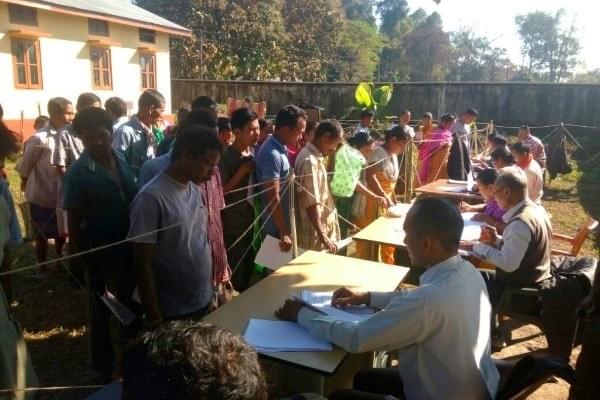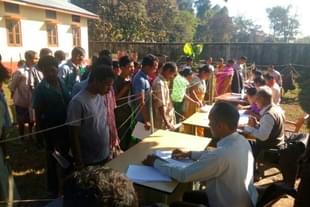Politics
Assam: NRC Exercise May Not Help Much With The Detection Of Ilegal Bangladeshi Immigrants
Jaideep Mazumdar
Aug 14, 2018, 09:07 PM | Updated 09:07 PM IST
Save & read from anywhere!
Bookmark stories for easy access on any device or the Swarajya app.


Despite all the brouhaha and fear-mongering over the final draft of the National Register of Citizens (NRC), published on 30 July, serious doubts are now being expressed over the whole exercise. It is now being feared that the entire NRC update exercise will ultimately turn out to be a futile or, at best, a flawed one. That is because the final NRC may well fall terribly short of popular expectations about the tens of lakhs of illegal Bangladeshi immigrants (IBIs) who are believed to be present in Assam.
A large segment of the 40 lakh-odd people whose names have been left out of the draft NRC are believed to be genuine Indian citizens. Those familiar with the whole process say that the final NRC would include the names of many of those left out from the draft NRC. That, in effect, means that the final NRC may exclude the names of just a few lakh non-citizens. That would be a severe disappointment for the people of Assam, who have been demanding for nearly four decades now that all the tens of lakhs of IBIs present in Assam be detected and deported from the state.
Assam Public Works (APW), the social organisation that filed the writ petition in the Supreme Court which led to the apex court ordering an update to the NRC for Assam, says that, as per their calculations, names of 41 lakh Bangladeshis had been included in the 2006 voters list of Assam. “The writ prayed for deletion of their (41 lakh illegal Bangladeshi immigrants) names and the preparation of a fresh voters’ list containing the names of only Indians,” said APW head Aabhijeet Sharma.
The APW’s contention about the presence of 41 lakh non-Indians in the 2006 voters list was based on a scientific set of calculations involving the census figures of 1951 onwards and the voters lists of 1971, 1991, and 2006. “We collated all the figures and arrived at the 41 lakh figure based on scientific projections and calculations. The most important thing is that the Supreme Court accepted our contention about the presence of 41 lakh names of illegal Bangladeshi immigrants in the 2006 voters’ list and thus ordered the updation of the NRC,” Sharma said.
If APW’s contention about the presence of 41 lakh IBIs in the 2006 voters list is accepted, then the total number of IBIs in Assam would have been about 70 lakh (when minors whose names do not figure in the voters list is included) that year. Considering the fact that the Muslim population in Assam (most IBIs are Muslims) grew by an average 30 per cent every decade, it can be said that the total number of IBIs in Assam in 2016 were 91 lakh. The number would be close to one crore today. Thus, if the final NRC leaves out the names of only a few lakh of the original 3.29 crore applicants, it would be sorely and severely disappointing for the indigenous people of Assam, who stand the risk of being reduced to a hapless minority in their own land.
As was pointed out in this article, the percentage of applicants whose names have been left out from the final draft NRC published in July-end is quite low in districts which are suspected to have a large presence of IBIs. Correspondingly, districts which have a low IBI presence have a higher percentage of applicants whose names have not been included in the NRC’s final draft. Thus, while 7.49 per cent of the applications for inclusion of names have been rejected in Dhubri, which has been inundated by IBIs and whose demography has been irreversibly altered by this illegal migration, tribal-dominated West Karbi Anglong district has a rejection rate of 17.49 per cent. The indigenous Assamese-dominated Tinsukia district has a rejection rate of 13.2 per cent while Sonitpur, which also has a marginal presence of suspected IBIs, has a rejection rate of nearly 18 per cent.
Bodo-dominated Baska district has seen 17.56 per cent of its applicants being left out of the draft NRC Muslim-majority Goalpara, which has a high presence of IBIs, has seen a rejection rate of 12.49 per cent. Nagaon, another district whose demography has been altered by large-scale immigration from Bangladesh and is now a Muslim-majority district, had 12.5 per cent of its applicants not being included in the draft NRC, while in Kamrup Metropolitan district (comprising state capital Guwahati), where the presence of IBIs is low, 17.49 per cent of applicants did not find their names in the final draft.
“This means that the IBIs have managed to procure documents fraudulently and by corrupt means and have managed to get their names included in the draft NRC,” said an activist who has been observing the NRC update process very closely. He said serious allegations of the whole process being compromised by corrupt officials tasked with the responsibility of verifying documents and vetting claims, have also surfaced.
As for the 40 lakh whose names do not figure in the NRC final draft, the process of filing claims will start soon. Since many of them are indigenous people of the state and migrants from other states who have settled down in Assam, their claims are expected to be eventually accepted and their names will figure in the final NRC. “That means only a few lakh names, at best, will be left out. That will negate the basic purpose of the entire exercise,” the activist said.
Going by all this, the final NRC, when it is ultimately out, will not bring to an end a tortuous and long chapter in Assam’s history. This chapter, which started with the anti-foreigners agitation launched in 1979 and continues till today, will reach closure only when the estimated one crore IBIs, or at least most of them, are detected.
Detection is the primary task. But grave doubts remain about the final NRC being able to bring about this closure.
Jaideep Mazumdar is an associate editor at Swarajya.





